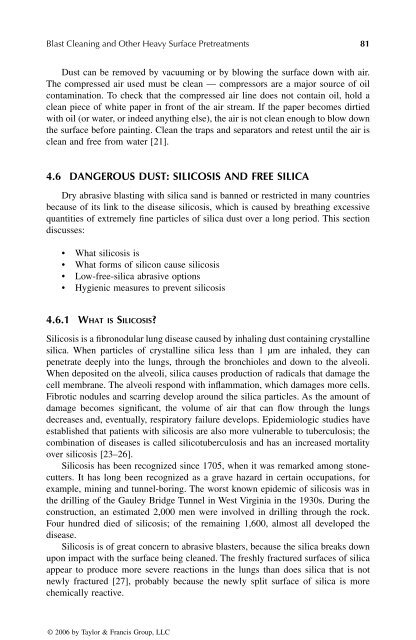© 2006 by Taylor & Francis Group, LLC
© 2006 by Taylor & Francis Group, LLC
© 2006 by Taylor & Francis Group, LLC
You also want an ePaper? Increase the reach of your titles
YUMPU automatically turns print PDFs into web optimized ePapers that Google loves.
Blast Cleaning and Other Heavy Surface Pretreatments 81<br />
Dust can be removed <strong>by</strong> vacuuming or <strong>by</strong> blowing the surface down with air.<br />
The compressed air used must be clean — compressors are a major source of oil<br />
contamination. To check that the compressed air line does not contain oil, hold a<br />
clean piece of white paper in front of the air stream. If the paper becomes dirtied<br />
with oil (or water, or indeed anything else), the air is not clean enough to blow down<br />
the surface before painting. Clean the traps and separators and retest until the air is<br />
clean and free from water [21].<br />
4.6 DANGEROUS DUST: SILICOSIS AND FREE SILICA<br />
Dry abrasive blasting with silica sand is banned or restricted in many countries<br />
because of its link to the disease silicosis, which is caused <strong>by</strong> breathing excessive<br />
quantities of extremely fine particles of silica dust over a long period. This section<br />
discusses:<br />
• What silicosis is<br />
• What forms of silicon cause silicosis<br />
• Low-free-silica abrasive options<br />
• Hygienic measures to prevent silicosis<br />
4.6.1 WHAT IS SILICOSIS?<br />
Silicosis is a fibronodular lung disease caused <strong>by</strong> inhaling dust containing crystalline<br />
silica. When particles of crystalline silica less than 1 µm are inhaled, they can<br />
penetrate deeply into the lungs, through the bronchioles and down to the alveoli.<br />
When deposited on the alveoli, silica causes production of radicals that damage the<br />
cell membrane. The alveoli respond with inflammation, which damages more cells.<br />
Fibrotic nodules and scarring develop around the silica particles. As the amount of<br />
damage becomes significant, the volume of air that can flow through the lungs<br />
decreases and, eventually, respiratory failure develops. Epidemiologic studies have<br />
established that patients with silicosis are also more vulnerable to tuberculosis; the<br />
combination of diseases is called silicotuberculosis and has an increased mortality<br />
over silicosis [23–26].<br />
Silicosis has been recognized since 1705, when it was remarked among stonecutters.<br />
It has long been recognized as a grave hazard in certain occupations, for<br />
example, mining and tunnel-boring. The worst known epidemic of silicosis was in<br />
the drilling of the Gauley Bridge Tunnel in West Virginia in the 1930s. During the<br />
construction, an estimated 2,000 men were involved in drilling through the rock.<br />
Four hundred died of silicosis; of the remaining 1,600, almost all developed the<br />
disease.<br />
Silicosis is of great concern to abrasive blasters, because the silica breaks down<br />
upon impact with the surface being cleaned. The freshly fractured surfaces of silica<br />
appear to produce more severe reactions in the lungs than does silica that is not<br />
newly fractured [27], probably because the newly split surface of silica is more<br />
chemically reactive.<br />
<strong>©</strong> <strong>2006</strong> <strong>by</strong> <strong>Taylor</strong> & <strong>Francis</strong> <strong>Group</strong>, <strong>LLC</strong>
















